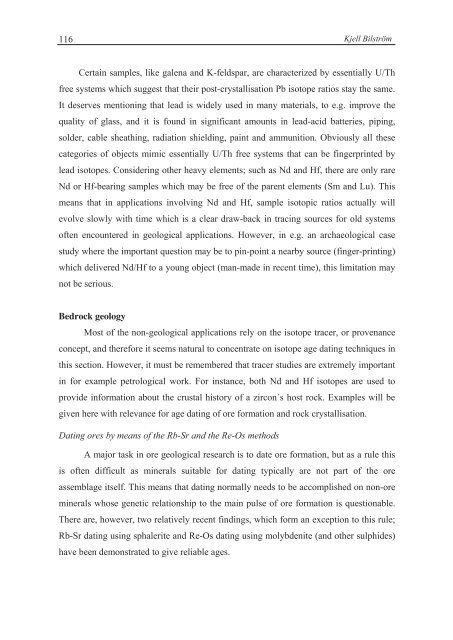instrumental techniques applied to mineralogy and geochemistry
instrumental techniques applied to mineralogy and geochemistry
instrumental techniques applied to mineralogy and geochemistry
Create successful ePaper yourself
Turn your PDF publications into a flip-book with our unique Google optimized e-Paper software.
116 Kjell Bilström<br />
Certain samples, like galena <strong>and</strong> K-feldspar, are characterized by essentially U/Th<br />
free systems which suggest that their post-crystallisation Pb iso<strong>to</strong>pe ratios stay the same.<br />
It deserves mentioning that lead is widely used in many materials, <strong>to</strong> e.g. improve the<br />
quality of glass, <strong>and</strong> it is found in significant amounts in lead-acid batteries, piping,<br />
solder, cable sheathing, radiation shielding, paint <strong>and</strong> ammunition. Obviously all these<br />
categories of objects mimic essentially U/Th free systems that can be fingerprinted by<br />
lead iso<strong>to</strong>pes. Considering other heavy elements; such as Nd <strong>and</strong> Hf, there are only rare<br />
Nd or Hf-bearing samples which may be free of the parent elements (Sm <strong>and</strong> Lu). This<br />
means that in applications involving Nd <strong>and</strong> Hf, sample iso<strong>to</strong>pic ratios actually will<br />
evolve slowly with time which is a clear draw-back in tracing sources for old systems<br />
often encountered in geological applications. However, in e.g. an archaeological case<br />
study where the important question may be <strong>to</strong> pin-point a nearby source (finger-printing)<br />
which delivered Nd/Hf <strong>to</strong> a young object (man-made in recent time), this limitation may<br />
not be serious.<br />
Bedrock geology<br />
Most of the non-geological applications rely on the iso<strong>to</strong>pe tracer, or provenance<br />
concept, <strong>and</strong> therefore it seems natural <strong>to</strong> concentrate on iso<strong>to</strong>pe age dating <strong>techniques</strong> in<br />
this section. However, it must be remembered that tracer studies are extremely important<br />
in for example petrological work. For instance, both Nd <strong>and</strong> Hf iso<strong>to</strong>pes are used <strong>to</strong><br />
provide information about the crustal his<strong>to</strong>ry of a zircon´s host rock. Examples will be<br />
given here with relevance for age dating of ore formation <strong>and</strong> rock crystallisation.<br />
Dating ores by means of the Rb-Sr <strong>and</strong> the Re-Os methods<br />
A major task in ore geological research is <strong>to</strong> date ore formation, but as a rule this<br />
is often difficult as minerals suitable for dating typically are not part of the ore<br />
assemblage itself. This means that dating normally needs <strong>to</strong> be accomplished on non-ore<br />
minerals whose genetic relationship <strong>to</strong> the main pulse of ore formation is questionable.<br />
There are, however, two relatively recent findings, which form an exception <strong>to</strong> this rule;<br />
Rb-Sr dating using sphalerite <strong>and</strong> Re-Os dating using molybdenite (<strong>and</strong> other sulphides)<br />
have been demonstrated <strong>to</strong> give reliable ages.













